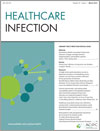
Healthcare Infection
Volume 19 Number 1 2014
Urinary Tract Infection
HI13047Preventing catheter-associated urinary tract infection: a happy marriage between implementation and healthier patients
Urinary infection is the second most common infection occurring in long-term care facility residents. Clinical diagnostic imprecision and a high prevalence of asymptomatic bacteriuria means these infections are overdiagnosed and overtreated, leading to adverse events from excess antimicrobial use. Antimicrobial stewardship programs to improve antimicrobial use for this indication need to be developed in long-term care facilities.
HI13043 Abstract | HI13043 Full Text | HI13043PDF (177 KB) Open Access Article
HI13031A single centre point prevalence survey to determine prevalence of indwelling urinary catheter use and nurse-sensitive indicators for the prevention of infection
Catheter-associated urinary tract infection (CAUTI) is the most common hospital-acquired infection. The aim of this study was to determine the prevalence of IUC use within a major metropolitan tertiary-referral teaching hospital and to explore nurse-sensitive indicators for the prevention of CAUTI in this context. The prevalence of IUC use in this tertiary teaching hospital was less than that in other centres. Nurses appear to be proficient in the management of IUC and associated drainage equipment and there is room for interdisciplinary improvement in documentation practices.
HI13033Clinical characteristics and antimicrobial susceptibility pattern of hospitalised patients with community-acquired urinary tract infections at a regional hospital in Taiwan
Common uropathogens in Taiwan (such as E. coli, Klebsiella spp. and Proteus mirabilis) are now resistant to many recommended first-line antibiotics. Taiwanese treatment guidelines for urosepsis should be updated to reflect changes in epidemiology of microbiology. Clinicians and hospitals should be aware of local antibiotic resistance patterns for optimal treatment selection.
HI13037Healthcare associated urinary tract infections: a protocol for a national point prevalence study
In Australia, there is no specific national strategy and surveillance system in place to address urinary tract infection surveillance. A consistent methodology for a point prevalence study on urinary tract infections is required. We propose a method for that could be used for a single hospital or national study.
HI13037 Abstract | HI13037 Full Text | HI13037PDF (212 KB) Open Access Article
HI13040Renal patients with asymptomatic bacteriuria do not need to be treated: results of a pilot observational audit
Inappropriate use of antibiotics for the treatment of asymptomatic bacteriuria in renal patients is common. Our study evaluated the safety and risks of adverse outcomes due to non-treatment of asymptomatic bacteriuria. This was found to be similar to that for patients who were treated. These findings suggest that it is safe not to treat asymptomatic bacteriuria in renal patients.

